Catalogue > Faire une recherche
Résultats pour : Tout le catalogue

Carlos Aires
Sweet Dreams Are Made of This
Vidéo | hdv | couleur | 4:21 | Espagne | 2016
The video shows two policemen wearing Spanish anti-riot uniforms, dancing a tango version of the famous Eurhythmics 80´s song in the luxurious and extremely decorated ballroom space of the XIX century palace Museum Cerralbo in Madrid. The fantastic lyric of the song “ Sweet dreams are made of this ” is the central motor of the piece. The tango version cove song has been arranged by the bandoneon player Fernando Girdini and recorded exclusively for the video. In its origins, tango was mainly a dance between two men. Tango was the result of the cultural mix of locals with African, Italian and Hispanic immigrants. It was originally forbidden by the church and rejected by high society, which resulted in its development in poor suburbs and working-class slums. The video reflects about the last years crisis, 15M movement, the violent riots, Cataluña independency, brutality of Spanish police and military forces and the recent antidemocratic Spanish law ” Ley Mordaza ” (the Gag Rule), becoming illegal and punished to take photos or videos of police forces or use of the police uniforms without the Government’s permission. Desire, power, decadence and frustration: they shoot horses, don´t they?
Carlos Aires was born in Ronda, Spain in 1974. He obtained a bachelor in Fine Arts at the University of Granada in Spain. Upon graduating in 1997, he moved to the Netherlands and completed his postgraduate studies at Fontys Academy (Tilburg, Netherlands), HISK (Antwerp, Belgium) and Ohio State University (Ohio, USA). He was honored with prestigious grants and awards, including: OMI Residency (USA), Edith Fergus Gilmore Award (USA), Generation2008 Caja Madrid (Spain), Young Belgian Art Prize (Belgium), 1st Award Young Andalusian Artists (Spain), Fulbright (USA) and De Pont Atelier (the Netherlands). He has participated in numerous exhibitions in national and international institutions, such as: CAC (Malaga, Spain), MACBA (Barcelona, Spain), Boulder Museum of Contemporary Art (USA), Imperial Belvedere Palace (Vienna, Austria), MUSAC (Leon, Spain), BB6 Bucharest International Biennale (Bucharest, Romania), B.P.S. 22 (Charleroi, Belgium), 5th Thessaloniki Biennale (Thessaloniki , Greece), Museo de Arte Carrillo Gil (Mexico City, Mexico), Canada Contemporary Art Museum (Montreal, Canada). His work can be found within significant public collections: ARTIUM (Spain), MACBA (Spain), Fondation Francès (France), ARTER (Turkey), CAC (Spain), Maison Particulière (Belgium), Ministry of Culture of Spain, Progress Art (Saudi Arabia), National Belgium Bank (Belgium), 21c Museum (USA), MAK (Austria) among others.


Shahi Aj
Letters Unwritten To Naiyer Masud
Doc. expérimental | digital | couleur et n&b | 63:37 | Inde | 2022
A pilgrimage taken by a group of readers to the ancestral house of a writer (a house that haunts all of his stories ) nested in the heart of a city , turns into an exploration of the city , into an exercise in mapmaking…into a hallucinatory encounter with the real. Told through the eyes of a stranger, a newcomer, walking through a modern bustling city, blanketed by a dream made of ancient lore's ,stories and signs, the film tries to explore the alchemical process behind the art of storytelling, that transmutes the 'real' that inspired it . And the impossible mirages a body of work can create in an obsessive readers mind which compels him to chase it ...
Born and brought up in Quilon India , Shahi A.J is An Alumni of Film and Television Institute of India , where he specialized in script writing and direction. His students work has been shown at various film festivals including Clapstick Kolkata, Signs Kerala, Hong Kong Film Festival etc. He teaches filmmaking St Joseph College . He is a recipient of the Practice Grant form Indian Foundation of Arts(IFA). His work has been shown in Kochi-Muziris Biennale 2022 and the International Documentary and Short Film Festival of Kerala (IDSSFK). His debut feature premiered at the International Film Festival of Rotterdam 2023 .

özge Akarsu
Emine
Fiction expérimentale | hdv | couleur | 11:39 | Turquie | 2020
Le 7 avril 2020, 8 mois se sont écoulés depuis qu'Emine Bulut a été assassinée par son ancien mari. Une lettre lui est adressée, ainsi qu'à toutes les victimes de fémicide dans le monde; une lettre qui questionne la féminité, le fait d'être une femme en Turquie...
Özge Akarsu est née et a grandi en Turquie. Elle vit actuellement en Belgique où elle étudie le cinéma d'animation à la KASK - Académie royale des Beaux-Arts, Gand. Avant de commencer ses études en animation, elle a obtenu un master en droit relatif aux droits humains, spécialisé en philosophie politique, à Istanbul (Turquie). Après trois ans de recherche doctorale sur Spinoza et la modernité, à l'Université d'Anvers (Belgique), elle s'est intéressée à l'animation et à la réalisation, qui l'aident à exprimer pensées, sentiments, idées et instincts qui ne peuvent être expliqués uniquement par les mots.
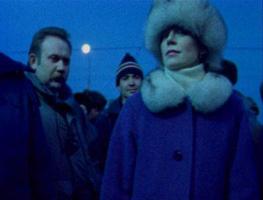

Chantal Akerman
D'est
Documentaire | 16mm | couleur | 107:0 | Belgique, France | 1993
Impressions d?Est après la chute du mur. « Tous ces pays, en pleine mutation, qui ont vécu une histoire commune depuis la guerre, encore très marqués par cette histoire jusque dans les replis même de la terre et dont maintenant les chemins divergent. » (Chantal Akerman) D?Est est un film quasiment sans parole, le contraire des Histoires d?Amérique (où la parole est prépondérante) et en même temps son prolongement. « D?Est est profondément fictionnel, parce que cela permet au spectateur de se raconter des histoires. Le cadre aussi y est pour beaucoup, il n?est jamais documentaire. Je ne dis pas, je vais tout vous dire sur la Russie. D?Est n?est pas qu?un film sur l?Europe de l?Est. Ces images, je les avais déjà en moi. Cela a à voir avec les camps, les évacuations, les images d?avant moi. » (Chantal Akerman)
Chantal Akerman est issue d'une famille émigrée d'Europe centrale dans les années 30. Elle est née à Bruxelles en 1950. Elle étudie le cinéma à l'Insas (Institut supérieur des Arts, du Spectacle et des Techniques de Diffusion), à Bruxelles. Après un premier court métrage, elle émigre à New York, où elle se passionne pour le cinéma expérimental de l'Américain Jonas Mekas et du Canadien Michael Snow, dont l'influence est perceptible dans les premières réalisations de la cinéaste. Sur place, elle réalise un court métrage et s'essaie au format long (Hotel Monterey, consacré à un hôtel pour nécessiteux de New York). Revenue en France, elle alterne, depuis 1968, documentaires (Un jour Pina a demande Pina Bausch, D'Est, Sud sur le lynchage d'un jeune Noir américain, De l'autre côté), et films de fiction (Toute une nuit, Nuit et Jour, etc.).

Kasper Akhøj, Guimaraes, Tamar
A Família do Capitão Gervasio
Doc. expérimental | 16mm | noir et blanc | 14:0 | Danemark, Brésil | 2013
Captain Gervasio`s Family is a 16mm black and white silent portrait of a Spiritist community in Palmelo, a small town in the interior of Brazil. It?s a town of 2000 inhabitants, half of whom are psychic mediums. The film refers to a map drawn by a Spiritist woman in Palmelo, charting twenty astral cities hovering above the whole of the Brazilian territory. Cities ?like those on earth, but infinitely more perfect?. The Spiritists in Palmelo practice what is known as `the magnetic chain?, a legacy from the German physician Franz Mesmer, the founder of Spiritism Allan Kardec, and the French botanist François Deleuze. The film is a collaboration between the artists Tamar Guimaraes (BR) and Kasper Akhøj (DK).
Kasper Akhøj was born in Copenhagen, Denmark where he lives and works. He studied at the Czech National Film School (FAMU), Städelschule - Staatliche Hochschule für Bildende Künste, Frankfurt, and the Royal Danish Academy of Fine Arts, Copenhagen. He is also a former participant of the Whitney Museum Independent Study Program in New York. He is represented by Ellen de Bruijne Projects in Amsterdam and has exhibited widely at major museums and biennials, both solo and in collaboration with Brazilian artist Tamar Guimaraes, most recently at last years 55th Venice Biennale, The Encyclopedic Palace. Tamar Guimarães was born in Belo Horizonte, Brazil and lives and works in Copenhagen, Denmark. She holds a BFA from Goldsmiths College, University of London, and MFA from Malmö Art Academy, Sweden. She is also a former participant of the Whitney Museum Independent Study Program in New York. She is represented by Galeria Fortes Vilaça in Sao Paolo, and has exhibited widely at major museums and biennials, both solo and in collaboration with Danish artist Kasper Akhøj, most recently at last years 55th Venice Biennale, The Encyclopedic Palace.
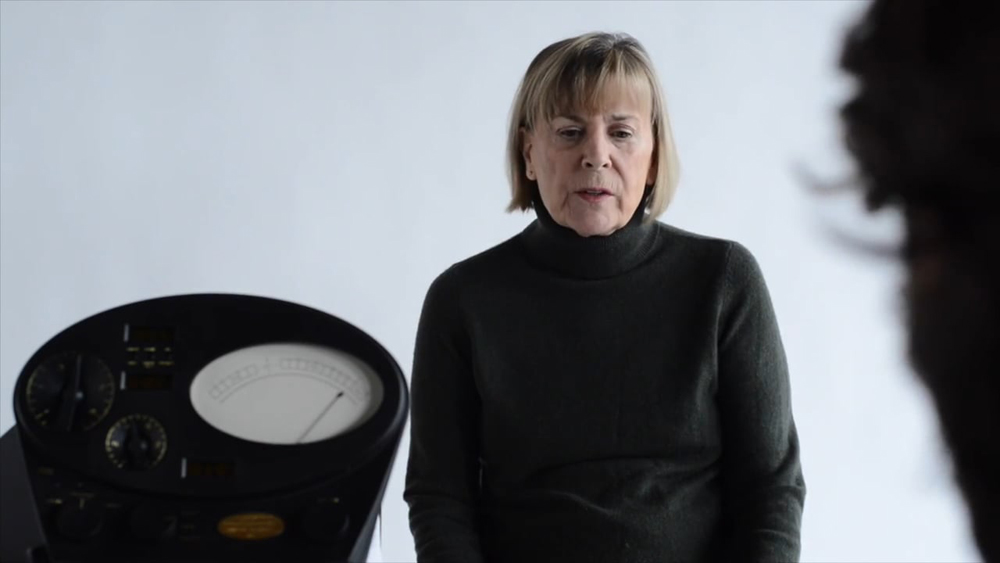
Edward Akrout, Jakob S. Boeskov
Quantum Political Feedback
Vidéo expérimentale | hdv | couleur | 8:0 | France, Royaume-Uni | 2017
In the video, the artists combine pseudoscience with repetition to investigate the connection between technology and truth. An E-meter device was exploited as a crude polygraph machine. Its pseudoscientific function is to "detect lies" in order to monitor a statement`s progression from lie to truth. Statements were read to and repeated by the participants. Through continuous repetition, the subjects built a relationship with the spoken words, which over time, matured into experiences and finally beliefs. All of the combined elements resulted in mettre en abîme the transformation of a political affirmation into a belief.
Edward Akrout is a Franco-British artist that works between London, New York and Paris. His practice, which largely includes painting, drawing and sculpting, is best described as abstract expressionism. Personal website: EdwardAkrout.com Representation: Lahd Gallery Jakob Boeskov is a Danish-Icelandic artist and filmmaker that works between New York and Copenhagen. Having graduated from The Royal Danish Academy of Fine Arts, his pieces have been shown in museums such as New Museum, Science Politiques, Moscow State Academy Art Institute and the Stedelijk Museum. Personal website: JakobBoeskov.com Representation: The Scandinavian Institute

Eren Aksu
Cosmorama
Fiction expérimentale | hdv | couleur | 8:7 | Turquie | 2015
They go to a day trip to an island next to Istanbul. They find themselves captivated by the never ending cityscape and sink into a contemplation on urban decay. Living in a concrete jungle is their future.
Born in Istanbul in 1987, Eren Aksu is a Berlin based filmmaker. He holds a Bachelor of Arts degree in Film& Television and currently studies Arts& Media at Berlin University of the Arts. His short films include Aydınlık (2013), Cosmorama (2015), İki Yer (2017).

Eren Aksu, Eren Aksu
Onun Haricinde, Iyiyim
Fiction | mov | couleur | 14:0 | Turquie, Allemagne | 2020
Se joignant à une récente vague d'immigration de la Turquie vers l'Allemagne, Asli est nouvelle à Berlin. Elle passe une audition pour devenir la voix de l'audioguide d'un musée archéologique, ce qui la confronte à des objets provenant de son pays d'origine, dont un autel monumental à Zeus. Les rencontres qu'elle fera pendant le reste de la journée révèleront l'absurdité du sentiment de déracinement.
Eren Aksu est réalisateur et monteur. Né à Istanbul (Turquie), il vit à Berlin (Allemagne). Il est titulaire d'une Licence en cinéma et télévision à la Istanbul Bilgi University (Turquie), ainsi que d'une Licence et d’un Master en arts et médias à la Universität der Künste Berlin (Allemagne). Il a participé à Talents Sarajevo (Bosnie-Herzégovine) en tant que réalisateur, et ses films ont été projetés dans de nombreux festivals internationaux, notamment aux Internationale Kurzfilmtage Oberhausen (Allemagne); au Sarajevo Film Festival (Bosnie-Herzégovine); au Filmfest Dresden, Dresde (Allemagne); et au Akbank Short Film Festival, Istanbul (Turquie). Son dernier film, "Other Than That, I'm Fine", a remporté le 3sat promotional award aux 66e Internationale Kurzfilmtage Oberhausen (Allemagne).
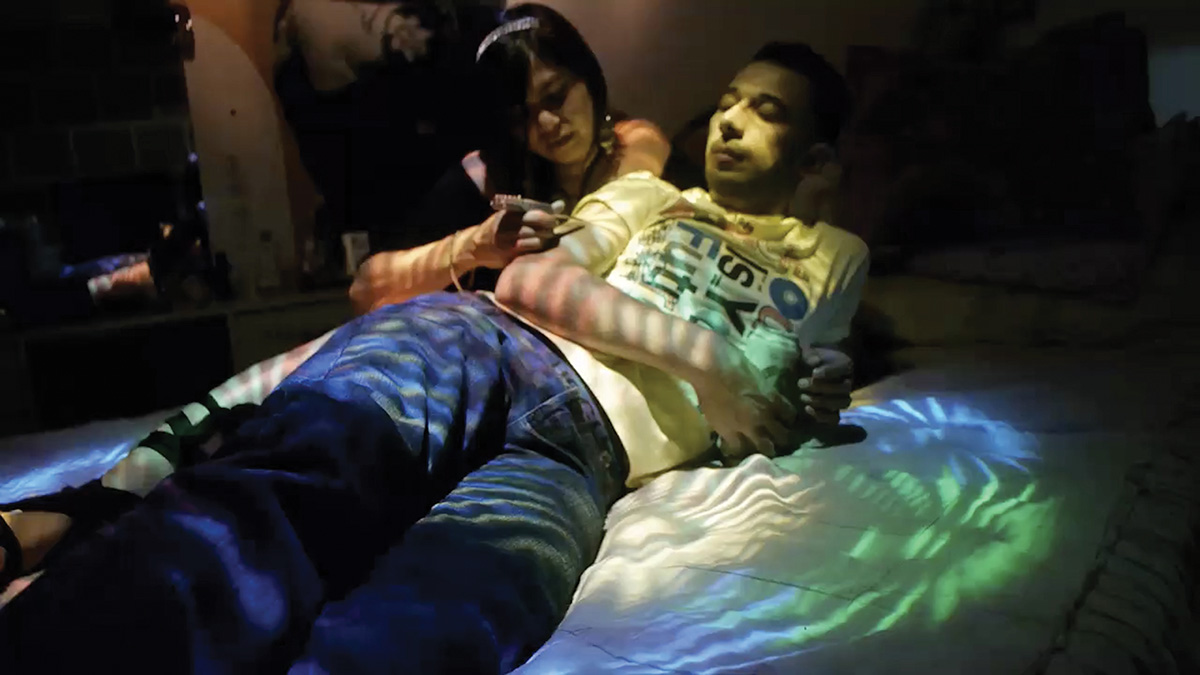
Liane Al Ghusain, Tarnowski Alghusain
Takht Coco
Doc. expérimental | mp4 | couleur | 6:26 | Koweït, Liban | 2013
'Coco's Bed' is a short film created for viewing on the iPad mini, commissioned for the X-apartment installation series by producer Matthias Lilienthal. X-apartment audience members follow Hassan, the protagonist of the film, to his own apartment where they find him in the flesh as well. 'Coco's Bed' was available on view for three days in July 2013 in the Bourj Hammoud district of Beirut. The neighborhood began as an informal refugee camp for Armenians fleeing the genocide in Turkey. It now additionally houses a large and diverse population of immigrants and asylum seekers from countries including Syria, Ethiopia, and the Philippines.
Stefan Tarnowski is a PhD Candidate at Columbia University’s Anthropology Department, Institute of Comparative Literature and Society and Institute for Comparative Media. His research focuses on Syria since the 2011 revolution, and in particular on the relations between technology, political economy and social imaginaries. He has a degree in Middle East Studies from Oxford University. His ethnographic fieldwork with Syrian media activists and civil society organisations was also funded by a grant from the Wenner-Gren Foundation 2018-19, and his most recent publication is a translation of and introduction to Dork Zabunyan's The Insistence of Struggle (IF Publications, 2019). Liane Al Ghusain (b. 1987, Kuwait) is an artist based in Abu Dhabi. Currently enrolled in the MFA program in Art & Media at NYUAD; she works primarily as a performance artist exploring various literary and craft forms. Born in Kuwait to a Palestinian family, Liane has focused on theater and writing throughout her life, having received a BA and MA in English with a focus on creative writing from Stanford University, with interdisciplinary honors in feminist studies. She has worked as an arts administrator, copywriter, language instructor, and yoga teacher.
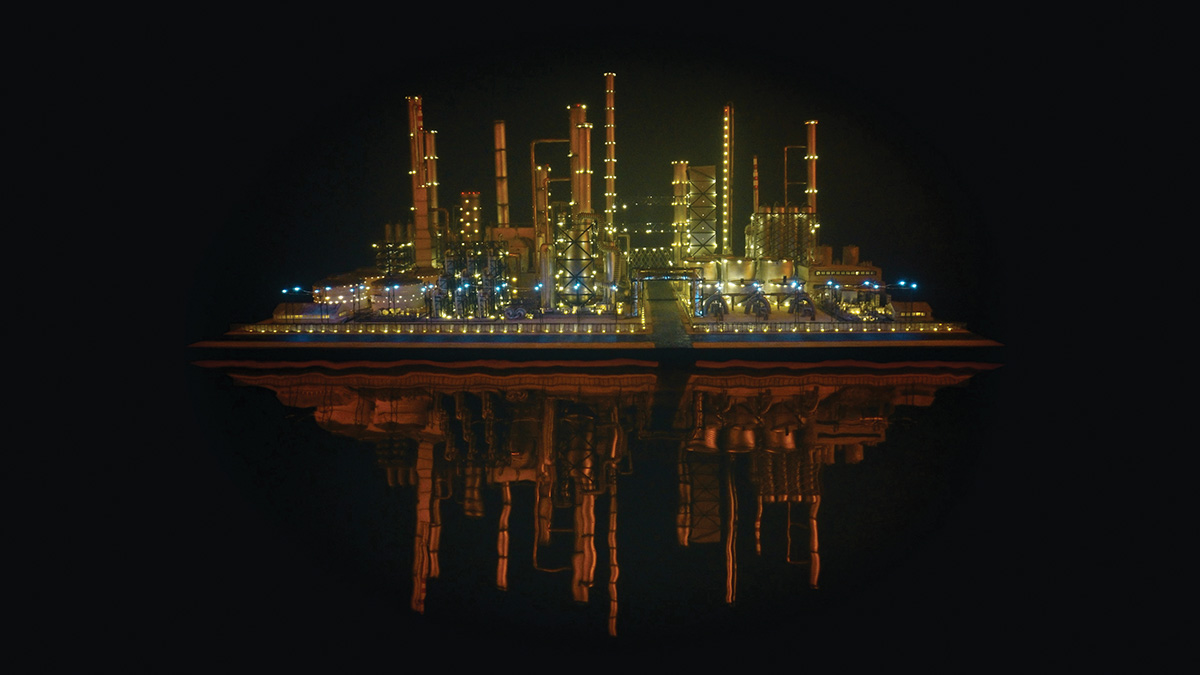

Monira Al Qadiri
Crude Eye
Film expérimental | 4k | couleur | 10:0 | Koweït, Allemagne | 2022
Growing up in Kuwait close to an oil refinery by the sea, the artist would create stories for the distant petroleum operation while passing by on a traffic bridge. As she envisioned an expansive panorama of lights, fire, smoke, and towers, Al Qadiri imagined it was a city-metropolis—"filled with beings and phantoms from another world.” This dream-like film hearkens back to these childhood memories, fusing eerie, slow views of a reconstructed miniature refinery with lines from poems about city lights and industrial landscapes. Crude Eye blurs reality with speculative memory, and we are unable to tell if the scene is a real place or a fantasy. The artist says: “The work attempts to reconcile a sense of childlike wonder with the toxic environmental destruction that the refinery inherently represents.”
Monira Al Qadiri (b. 1983) is a Kuwaiti visual artist born in Senegal and educated in Japan. Spanning sculpture, installation, film and performance, Al Qadiri's multifaceted practice is mainly based on research into the cultural histories of the Gulf region. Her interpretation of the Gulf's so-called "petro-culture" is manifested through speculative scenarios that take inspiration from science fiction, autobiography, traditional practices and pop culture, resulting in uncanny and covertly subversive works. She is currently based in Berlin.

Monira Al Qadiri
Behind the Sun
Vidéo | hdv | couleur | 10:0 | Koweït | 2013
After the first Gulf War in 1991, countless oil fields in Kuwait were set ablaze during the retreat of invading forces. Those months following the war were nothing short of the classic image of a biblical apocalypse: the earth belching fire and the black scorched sky felt like a portrait of hell as it should be, an almost romanticized vision of the end of the world. Werner Herzog, lured by the surrealism of this present-day hell, shot his docu-fiction film “Lessons of Darkness” there which placed images of the oil fires alongside Christian biblical texts and a Wagner soundtrack. Inspired by his endeavor, this video re-explores the cataclysmic event and attempts to expand its meaning, especially as the idea of imminent doom is even more omnipresent today. Amateur VHS video footage of the oil fires is juxtaposed with audio monologues from Islamic television programs of the same period. At the time, the tools used to represent religion were geared towards visualizing god through nature. Trees, waterfalls, mountains, and animals were the visual staple of religious media, and the narration was not that of the Koran, but of Arabic poetry recited by a skilled orator with a deep voice.
Monira Al Qadiri is a Kuwaiti visual artist and film maker born in Senegal and educated in Japan. In 2010, she received a Ph.D. in inter-media art from Tokyo University of the Arts, where her research was focused on the aesthetics of sadness in the Middle-East region stemming from poetry, music, art and religious practices. Her work explores the relationship between narcissism and masculinity, as well as other dysfunctional gender roles. She is currently expanding her practice towards social and political subjects. Al Qadiri has taken part in exhibitions and film screenings in Tokyo, Kuwait, Beirut, Dubai, Berlin, New York and Moscow among others. She is also part of the artist collective GCC, who has recently held a solo exhibition at MoMA PS1 in 2014.
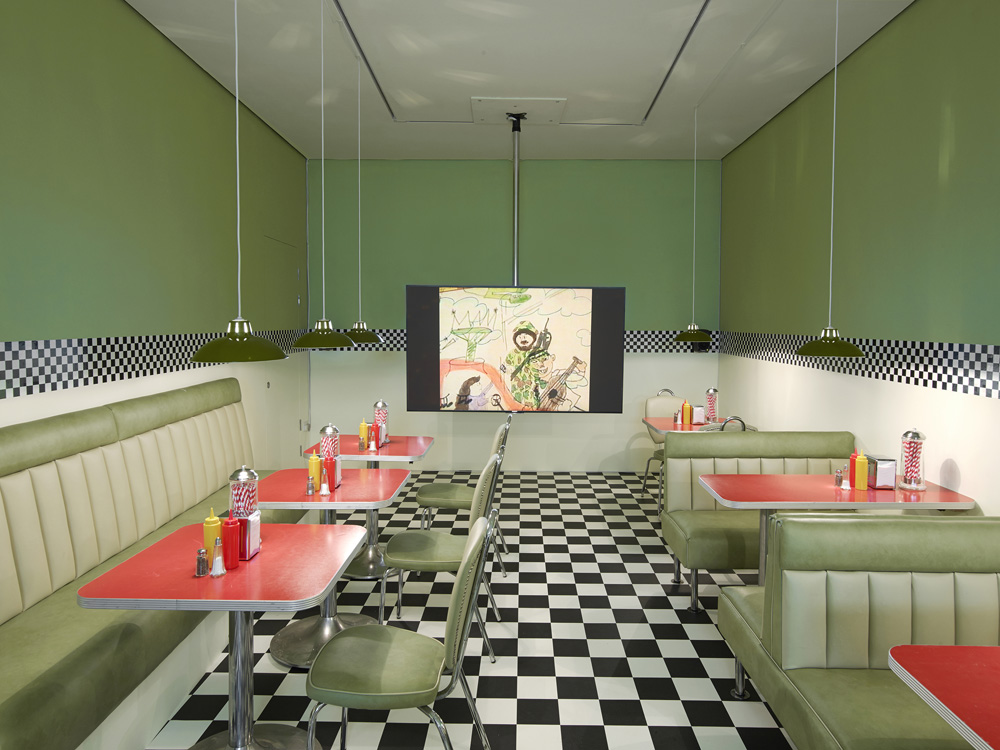
Monira Al Qadiri
The Craft
Film expérimental | hdv | couleur | 16:0 | Koweït | 2017
“ The Craft ”is a film that revolves around childish fictions laced with serious suspicions towards the real world. Using the lens of family history, the film dissects the artist’s own past to reexamine an uncanny relationship taking place in the shadows of her major life events: “ Were my parents conspiring with aliens behind my back ” Reality gradually disintegrates like quicksand around this central question, as paranoia and speculation begin to take hold. Futuristic architecture, popular culture, dream readings, junk food, alien abductions, geopolitics, international diplomacy, war and peace; all of these once solid staples of modern life now become tinted with a general sense of distrust, overshadowing everything. Like a ticking time bomb at the center of the nuclear family unit, the suspicion reaches a crescendo when the protagonist suddenly discovers that the American century has finally ended.
Monira Al Qadiri is a Kuwaiti visual artist born in Senegal and educated in Japan. In 2010, she received a Ph.D. in inter-media art from Tokyo University of the Arts, where her research was focused on the aesthetics of sadness in the Middle-East stemming from poetry, music, art and religious practices. Her work explores unconventional gender identities, petro-cultures and their possible futures, as well as the legacies of corruption. She is also part of the artist collective GCC, who held a solo exhibition at MoMA PS1 in New York (2014). Monira was recently based in Amsterdam, and underwent a two year artist residency at the Rijksakademie until the end of 2017.


Loukia Alavanou
On the Way to Colonus
VR vidéo 360 | mov | couleur | 20:0 | Grèce | 2021
Blind Oedipus, in older age, left Thebes as an exile accompanied by Antigone, who was both his daughter and sister. They sought refuge in Colonus of Athens. What if the tragic hero of Sophocles’ play 'Oedipus at Colonus' was a Romani nomad residing in today’s post-industrial outskirts of western Athens? OTWTC is a ‘docufictional’ VR film cast with Romani amateurs who live at the ghettoised toxic wastelands of Thriasian Plain, where Sophocles’ wandering hero is meant to have passed from. Consisted of a spatial sound design (ambisonics), the film's audio incorporates location sounds recorded inside the dwellings that merge “high” and “low” culture, often carrying with them the “eerie echoes” of dubbed TV series, speaking themselves about “Oedipal conflicts”, ‘absent fathers’, ‘incest’, murder and death.
Loukia Alavanou is a moving image artist and filmmaker. She is representing Greece at the 59th Venice Art Biennale with the exhibition “Oedipus in Search of Colonus. Alavanou holds an MA in Photography from the RCA in London. She was the winner of the 5th Deste Prize. In recent years, after receiving international acclaim, she started to be involved with the production of VR films and founded the first VR production company in Greece. She held a retrospective exhibition at State of Concept, Athens in 2018. For the years 2021 and 2022 Alavanou is a fellow artist at ONX Studio, organised by Onassis USA and the New Museum in NY. Alavanou’s work has been presented by institutions and festivals including KANAL Centre Pompidou, Accelerator, Stockholm, Gucci Garden, Kino Der Kunst, Palais de BOZAR, Palais de Tokyo, Athens Biennale, Moscow Biennale, Fiorucci Art Trust, The Museum of Cycladic Art, Benaki Museum. Her films are part of numerous collections including the Onassis Collection, the Dakis Joannou Collection, The Center for Art and Media Karlsruhe/ ZKM, PCAI/ Polyeco Contemporary Art Initiative.

Jean-baptiste Alazard
La Buissonnière
Documentaire | hdv | couleur | 59:0 | France | 2013
C`est l`été. Un pilote et un copilote errent sur des routes perdues en quête d`absolu.
Jean-Baptiste Alazard nait en 1985 en Aveyron. En 2006 il intègre La fémis en montage, où il réalise Ma bande magnétique arrière, Mittelwerk Express et Moussem les morts. Tout en continuant son travail de monteur, il crée en 2011, en collaboration avec la photographe Lise Lacombe, le collectif La France Entière, avec qui il part à la recherche de ceux qui pourraient être les figures de la nouvelle ère : ses dissidents, techniciens, empereurs, prêtresses et prophètes. La Buissonnière est le premier film issu de ce projet. Il en prépare un second qui sera tourné en 2014 : L’Empire.

Michiel Alberts
Another Gate Before the Law
Vidéo expérimentale | hdv | noir et blanc | 17:13 | Pays-Bas, 0 | 2017
Another Gate Before The Law (HDVideo, B&W, 17m13, Michiel Alberts, 2017) Michiel Alberts is currently working on a series of K. Films. The films relate to different short texts by F. Kafka. Michiel Alberts performs and films his actions in order to transform the stories into a visual image bringing it to current and existential scenery. The film Another Gate Before The Law refers to the text Before the Law, by F. Kafka. The film is a dark poetic image dealing with the present state of our time and to current human conditions.
(Born The Netherlands, 1972. Lives and Works in Antwerp, Belgium.) Michiel Alberts is a Visual artist working with the media Performance, Film and Photography. In his film works he focuses upon his performative presence, movements with duration or repetitive actions. Through the usage of single angel point, the audience is invited to experience a frozen state and relate to existential questions and human conditions. His films can be described as a still picture moving, a state of presence unresolved. “ My physical presence functions as a performative tool to question human conditions, cosmic order, time and landscapes. Through forms of abstraction I bring my content from a specific happening, or a specific social context to a larger existential scenery." Michiel Alberts has studied Visual Art at the H.I.S.K. institute in Antwerp and Gent (2008). He also completed a Master of Arts at Dasarts in Amsterdam (2005) and completed the Acting School of Maastricht (1997)


Almourad Aldeeb
Flut
Doc. expérimental | 16mm | couleur | 11:25 | Syrie, Allemagne | 2022
Le 14 juillet 2021, la vallée de l'Ahr, en Rhénanie, a connu une catastrophe naturelle : une inondation a coûté la vie à plus de 130 personnes. La ville d'Ahrweiler ressemble à une ville fantôme - un spectacle dystopique. Abdo, un habitant de la ville, partage le chagrin de la perte et revit le sentiment de peur et d'impuissance. Pour Abdo, qui est né et a grandi à Alep/Syrie, ce n'est pas la première catastrophe.
Almourad Aldeeb (he/him) is a Syrian filmmaker based in Germany. He was born and raised in Homs, Syria 1991. Currently, he is studying film at the Academy of Media Arts in Cologne. His practice is a search for a poetic reflective expressions, and intense narrative forms..
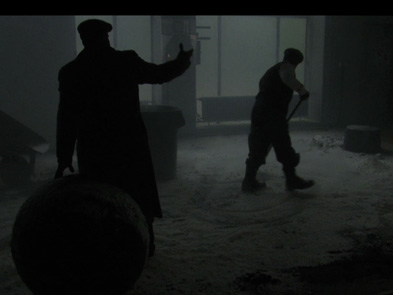
Adrian Alecu
Gravitation
Fiction expérimentale | hdv | couleur | 3:0 | Roumanie, Pays-Bas | 2011
"GRAVITATION" deals with the idea of European identity and the desire to export it, desire which is deep inside of this identity. A long tradition. It is a tale of mistaken identity and murder, human weakness and individual deficiencies. It is a fatalistic tale of one man?s vain struggle to escape his own limitations, unfortunately an impossibility in the world of noir. The film Gravitation gives me the opportunity to investigate the structuralist film concept, the so-called ?Film Low?. The different actions which in the real life stay under the Nature Low, will have to be in the film under the ?Film Low? : montage, light, perspective, acting, actors and camera choreography and more others film components . Using very reduced but very eloquent / representative objects for the film set will create pictures which have to suggest the acting place. This objects must have a strong relation to the `film place` (typical for the place) so that the viewer, by his visual perception, can be able to trust the authenticity of the picture as a film construction - instead as an illustration. The question for me, is how far I can reduce this elements and on which things, on which elements I have to reduce the decoration of the film `stage` to get the visual suggestion instead of the illustration. That it is one of my research point. The Film will use apparently prosaic structures (narration) but during the editing and the alienation process it has to be percepted as a poetic work. Poetry deals with tempo, with rhythm. In the film, economic tempo and rhythm are matters who belong and are decided more in the editing room. The alienation process is one of the main points in my Film. The Film process have to be transparent, so that film structures and effect modalities will recognize it. I believe that this transparency offers the opportunity to reflect about new modalities of telling a story using the Film. To me, this alienation process helps us to make our `automated` perception - by language and social conventions, more difficult and thereby to get a new vision of the things which can correct our relationship to the environment. Then new forms appear, and this forms and their determinant process become the actual object of artistic perception, in the end the the art subject. Using a linear visual guided treatment will permit to give up a psychological motivation, and to make the non-artistic interpretations harder. The Sound will have a strict autonomous function in Film, and will try so much possible to not be used as a naturalistic synchronic language.
Born at 20 Mai 1972 in Bucharest / Romania EDUCATION 1990 2008 2011 Liceul ?Spiru Haret?, Bucharest / Romania Diplom in Art studies at the University of Fine Arts of Hamburg Jan van Eyck Academie post-Academic Institute for Research and Production Fine Art, Design, Theory, Maastricht / The Netherlands

Lee Alex
the Fold
VR expérimental | mp4 | couleur | 0:0 | USA | 2019
"The Fold" is a non-linear film and virtual reality-based art game involving rooms with doors containing a concept folding into other rooms with doors. Inspired by Jorge Luis Borges' short story The Garden of Forking Paths, each room consists of an idea inspired by structuralist & surrealist literature, mathematics, the readymade virtual object, and more. This project is a virtual 'escape the room' concept where some rooms are puzzle experiences and others are more experiential. All rooms follow a similar visual monochromatic motif. To date, the project involves five rooms: the Doors, the Fold, the Grid, the Meridies, and the Cave. Subsequent rooms will be released as this project is a long-term episodic series. Chapter one is debuted at Berlin Recontres International.
Alex M. Lee is an artist who utilizes 3D animation, video game engines, virtual/augmented/immersive reality platforms, and the potential of simulation technologies in order to visualize and complicate our perception of time, space, image and light - culling from concepts within science, science fiction, physics, philosophy, and modernity. He received his BFA (2005) and MFA (2009) from the School of the Art Institute of Chicago. Born in Seoul, South Korea, Lee was raised in the USA and is associate professor in the Digital Arts & Sciences Program at Clarkson University located in Potsdam, NY - a private science and engineering university located north of the Adirondack Mountains where he divides his time between Potsdam and New York City. Lee has exhibited internationally in North America and Asia. Selected exhibitions include: Mio Photo, Osaka, Japan; Daegu Art Factory, Daegu, Korea; The Gene Siskel Film Center, Chicago, Illinois; Eyebeam: Center for Art & Technology, New York, NY; Gallery DOS, Seoul, Korea; Museum of Contemporary Art, Montreal, QC. His work has been published in articles covering art, science, and culture including: Metaverse Creativity, Canadian Art, and Routledge Press.


Amy Alexander
What the Robot Saw
Installation multimédia | 0 | couleur | 0:0 | USA | 2020
An invisible audience of software robots continually analyze content on the Internet. Political trolls and YouTube celebrities gain visibility because social media ranking algorithms promote addictive videos to the top of search and recommendation rankings. What the Robot Saw is a continuously-generated livestream film that uses contrarian algorithms to constantly curate some of the least attention-grabbing videos recently uploaded to YouTube. These videos, and their creators, are rendered largely invisible by social media algorithms. Their primary audience may be the robots that rank them. What the Robot Saw uses computer vision algorithms to curate videos and study their subjects. It focuses on first-person, camera facing narrators. The robot continually assembles its film and labels its “talking head” performers in a robo-fantastical cinematic style. The Robot titles its human subjects according to the demographically-focused feature set of Amazon Rekognition, a popular facial analysis system. In a robot-centric world, attributes like presumed age, gender, and emotion might better identify us than our names. The title is a reference to early 1900s What the Butler Saw “peep show” films. Both the butlers and the Robot got a superficial glimpse of a seductive “show;” they could not really understand the objects of their obsession.
Amy Alexander is a professor and hackernaut who has been making computationally-based art projects since the 1990s. Amy is a Professor of Computing in the Arts in the Visual Arts Department at UC San Diego. She is an algorithmic filmmaker and performer who has focused throughout her career on the fuzzy borders between media and the world. Amy’s work has frequently addressed algorithmic subjectivity in digital culture by creating transparently biased, sometimes funny alternatives. Her latest project returns to this theme — this time taking on the attention economy and social influence of algorithms used for social media rankings and facial classification. Using computer vision and machine learning-based methods of curation and production, What the Robot Saw, is a perpetual live stream that depicts the cinematic fantasy of the surveillant AI robots who “see” the social media content few humans get to experience. Amy’s art practice has spanned net art, software art, computationally-based installation, audiovisual performance, and film. Her research and practice over the years has focused on how contemporary media – from performative cinema to social media – changes along with cultural and technological shifts. Amy’s projects have been presented on the Internet, in clubs and on the street as well as in festivals and museums. She has written and lectured on software art, software as culture, and historical and contemporary audiovisual performance. She has served as a reviewer for festivals and commissions for new media art and computer music.Her recent lectures span topics including algorithmic bias and subjectivity, cultural anthropologies of gender roles in 20th and 21st century computing, and systems and disruption in 20th and 21st century media.


Vito Alfarano, Francesco Biasi
THE PASSENGERS
Vidéo | hdv | couleur | 14:50 | Italie | 2023
Avec les détenus de la prison de Brindisi comme protagonistes, THE PASSENGERS parle de l'attente, ce moment où tout s'arrête, où l'on a le temps de réfléchir et de repartir en pleine conscience. Les passagers accueillent tout le monde dans leur wagon, l'important étant de se laisser porter par la puissance évocatrice de leurs récits. Ils racontent leur attente, leur rapport au temps, ils manifestent leur fragilité et en dansant ils s'amusent, ils jouent avec eux-mêmes. Entre lectures de passages écrits dans la cellule, musique entraînante et chorégraphie de groupe, les protagonistes libèrent tout le monde : parce que tout le monde est prisonnier de quelque chose qu'il porte en lui. Et le partage est l'outil qui permet de s'en libérer. La mise en scène est signée Vito Alfarano, tandis que la chorégraphie est un travail à quatre mains entre Alfarano lui-même et Francesco Biasi, le jeune chorégraphe de la compagnie. Les textes sont de Michele Caiulo, qui a écrit ses pensées et ses réflexions dans son journal pendant sa détention. Choisis par Vito Alfarano et réadaptés par Marcello Biscosi, ils sont devenus le guide du spectacle. Le projet bénéficie du soutien de la Garant des personnes soumises à des mesures de restriction de la liberté personnelle du Conseil régional de la Région des Pouilles et est réalisé en coopération avec la Direction de la Prison de Brindisi, Ministère de la Justice.
VITO ALFARANO _ Directeur artistique et chorégraphe Il a commencé sa carrière comme danseur indépendant en travaillant avec différents chorégraphes. Avec ses chorégraphies et ses scénographies, il a remporté les premiers prix lors de concours internationaux et de festivals de scénographie. Il est le directeur artistique d'AlphaZTL Company of Dynamic Art basée à Brindisi (Italie), qui s'occupe d'ART & SOCIAL avec de la danse contemporaine et de la screendance, et de BRINDISI PERFORMING ARTS, un festival d'inclusion sociale par le biais des arts du spectacle. ____________________________ FRANCESCO BIASI _ Vidéaste et chorégraphe Danseur, vidéaste et chorégraphe. Sa contamination entre la danse, la vidéo et la réalité caractérise sa recherche artistique. Il tente de transmettre à ses danseurs le pouvoir de l'interprétation personnelle afin que chacun puisse exprimer au mieux son âme.

Greta Alfaro
In Ictu Oculi
Art vidéo | dv | couleur | 10:35 | Espagne | 2009
There is a table in the middle of the countryside, but the guests are absent. There is a feast of food and wine waiting in the cold weather and the dry landscape. The vultures are to come and eat our food and destroy our setting: the still life, the banquet, the space of enjoyment and civilization. The vultures, the beasts linked to death and dirt, to violence and fear, arrive by surprise, and like in a fable, represent for us some of our own qualities.
Greta Alfaro (Spain, 1977) is currently studying an MA in Photography at the Royal College of Art, London. In recent years she has been the recipient of several grants and scholarships among which are Matadero-City Council of Madrid, Casa de Velázquez, Fundación BilbaoArte, the Government of Mexico or the Genesis Foundation. She is taking part in the exhibition Bloomberg New Contemporaries 2010 at the ICA, London, and her recent solo shows include In Ictu Oculi, in Galería Marta Cervera, Madrid and Carpe Diem, Lisbon, and Elogio de la Bestia, in Centro de Arte Contemporáneo Huarte, Spain.